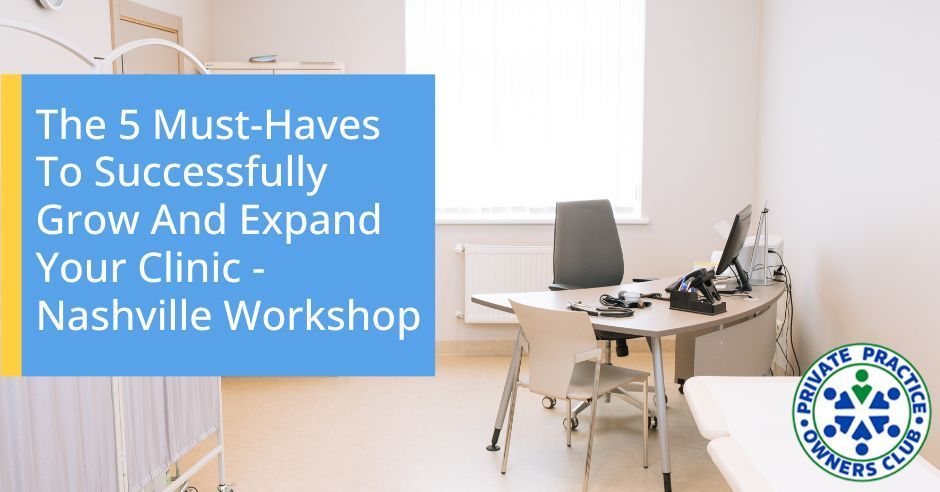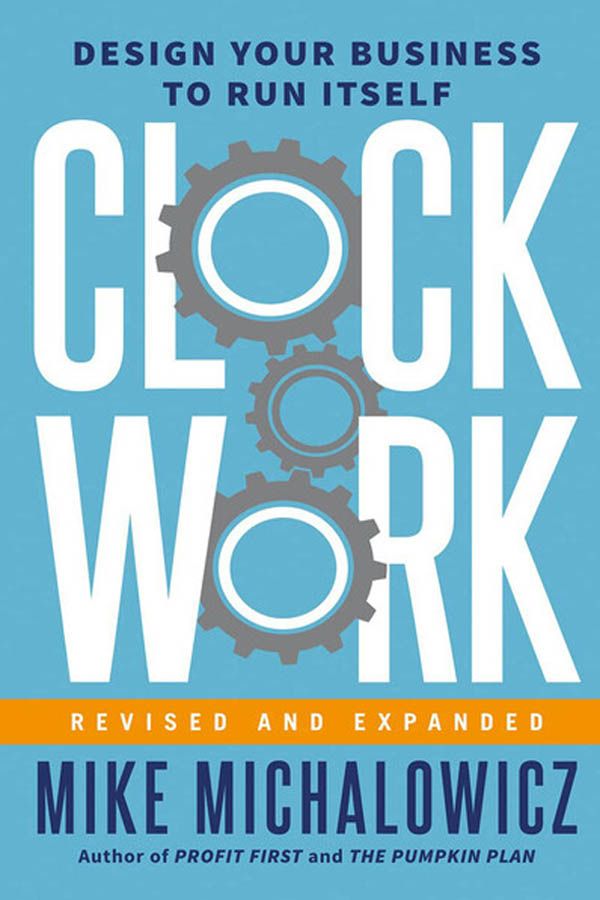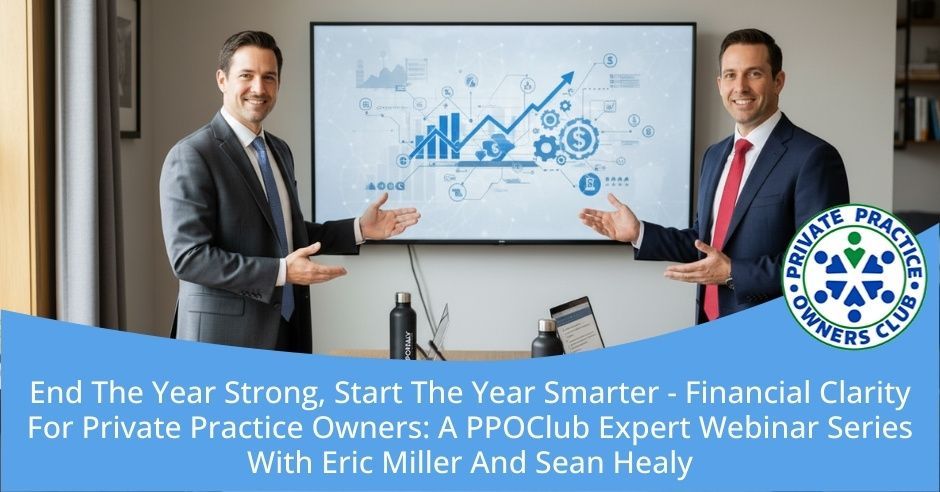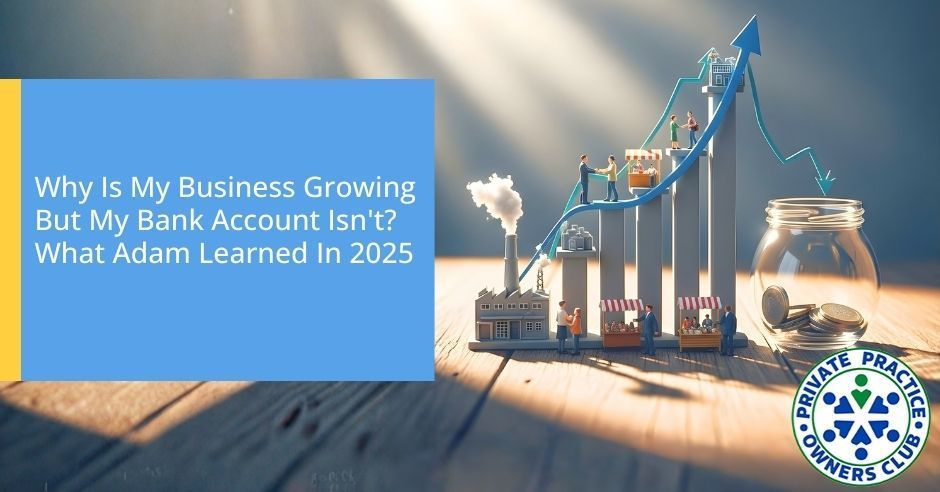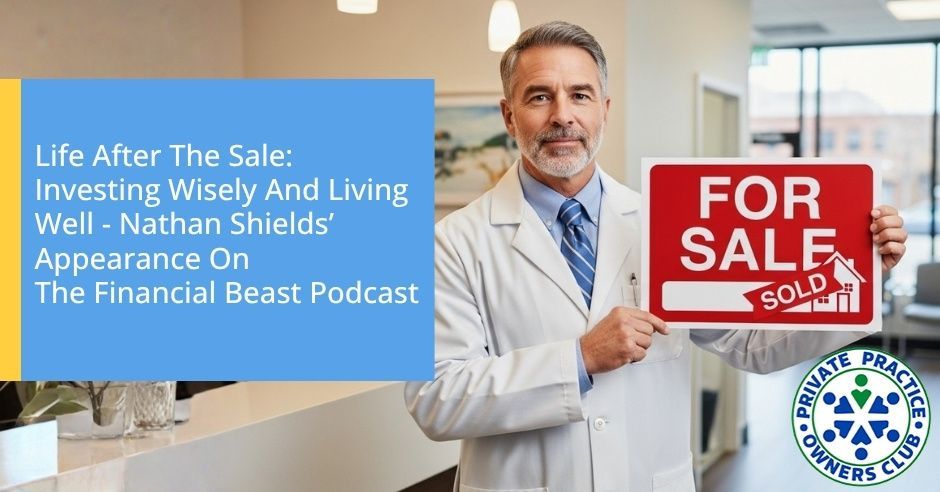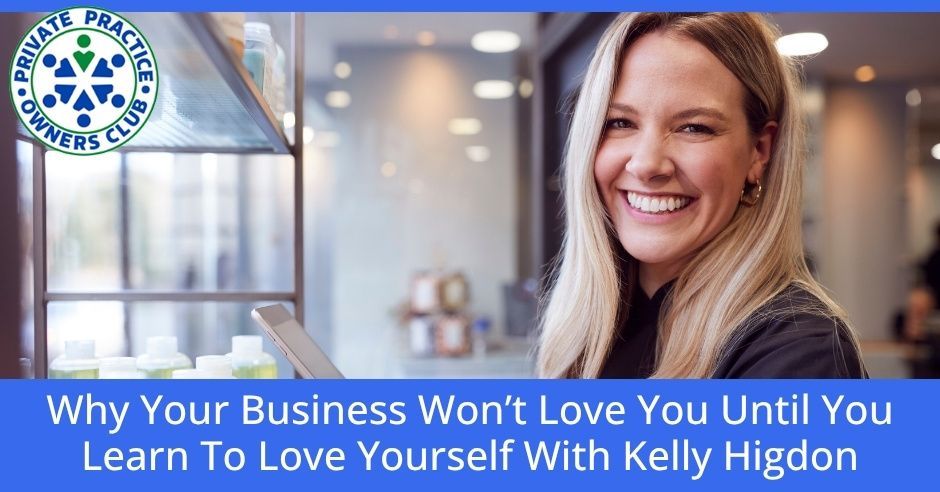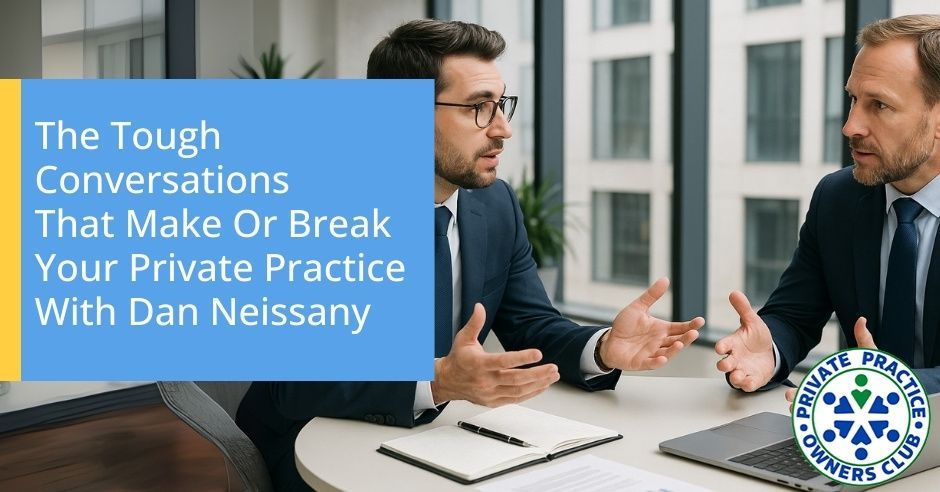Ready to punch through plateaus and scale with purpose? In this high-energy solo episode, Nathan Shields—former multi-clinic owner and founder of the Private Practice Owners Club—shares the five guidelines he uses with coaching clients to ignite sustainable growth. Whether you’re running a single location and considering hiring a new therapist, or looking to open your next location, these principles will tighten your systems, lift profitability, and buy back your time, making it easier and more likely that expansion is a success.
Stick around to hear real-world examples, quick-hit action steps, and the one mindset shift that prevents growth from crushing culture. Plus, Nathan drops a super-early-bird invite to the next PPOClub beach-side conference—Elevate & Expand-- in Destin, FL, October 2-4, 2025. Register Here ===>https://ppoclubevents.com/homepage
---
Listen to the Podcast here
The 5 Must-Haves To Successfully Grow And Expand Your Clinic - Nashville Workshop
Welcome to the show. This episode is a little bit unique from most of my episodes because it is simply a presentation that I did at a recent Nashville workshop regarding the five successful things that you need to do in order to grow and expand. The presentation itself will provide you with a ton of value, but if you are super interested and you are goal-oriented towards growth and expansion at any point in your organization, you have to connect with us at our annual conference in Destin, Florida.
It's going to be right on the beach, a beautiful location. The speakers are going to be amazing. I have speakers procured who have 10, 20, 40 clinics, and they're going to share their secrets. One of the more important things is to just connect with other owners and learn from them. Learn that you're not alone. We're in this together, and other people have figured out the same problems that you're dealing with right now. We share those things during the conference.
Make sure you register. Go to
PPOClub.com. Under the resources and events tab, you'll be able to register. There are super early bird discounts if you register before July 1st. There's even an early bird discount after that, although the price goes up. Make sure you register now, book your hotel, and we'll see you in Florida.
---
Who's looking to grow? What are some of your goals for growth? I love it. What's your five-year plan? Where do you want to be in five years?
I'd like to have three more locations.
Great. Let's get there. What is your five-year plan? We all want a company where we can take a month off and not catch a single phone call from the company. In order to do that, we need some guidelines. How do you know when you're ready for the next clinic? If I were to ask you, Connor, what determines whether you open up the next site or not?
Profit.
Rule 1: Prove The Model First - Achieving Profitability
Cool, good. Let's talk about some of the guidelines that I learned about growth. We're going to talk about five key rules for growth. The five areas we need to consider if you're going to grow in scale a private practice in healthcare. Connor brought up the first one, profitability. How are you going to grow if your current model isn't profitable? It’s probably not a good idea if you're going along at 10% profit margins to think, “Let's do a second one of these.”
How can I do more of this? 10% is not enough. We need to be profitable. You've got to know your KPIs. Some people, as they join the Private Practice Owners Club, might have been overwhelmed by the KPI dashboard. There's a reason why we're forcing you to put in your KPIs on a regular basis.
How do you drive a car if you don't have a dashboard, if you don't know how fast you're going, if you don't know if the tank is full, or if you don't know if you're overheating? You don't want to wait until you run out of gas or the smoke is coming from the engine. You've got to know your numbers cold. You've got to know them. They're not foreign to you. These aren't alien to you. You've got to know them off the top of your head. We'll go through some of them.
You've got to build a strong core team. When you went from one to two clinics, did you have a core team in place? The start of one. When you went from 2 to 3 clinics, was it easier because you had a team in place? It’s so much easier when you have leadership in place because you have a core team to do that.
Create and document systems. Those of you who are in the Private Practice Owners Club, we have the vault. It's a bunch of systems written down. You need to have your own vault. That's what Ujwal is waking up at 5:00 AM every morning to do. It is to create his own vault with videos, templates, job descriptions, roles, responsibilities, and KPIs. Every role has a KPI, every role has a product, and every role has descriptions. They have scripts for how they greet the patient at the front door, collect it, you name it.
This is what makes McDonald's grow to the biggest fast food chain in the world because they can plug a fifteen-year-old boy at the counter. He follows the system and gets the same product, and we still go and buy it. It's systems-dependent versus people-dependent. What does that mean, Systems dependent versus people dependent? We've all been people-dependent at some time.
That person is doing their role at the front desk, and they do it very well. If you don't have systems behind it, what happens when they leave? They take the systems with them. You're dependent upon them, and then you're having to try to train the next front desk person on the way that person did it, or how you wanted to do it. There was no system. The person was the system.
Tanny knows all about this. When you go to sell your practices, what's the difference in value? If someone is coming to buy a practice and it's built on legitimate systems that generate patients and profit, what value does that create when you're going to sell? Your company is worth more when it's system-dependent and not people-dependent. Ensure your demand is scalable.
Your company's value increases when it's system-dependent, not people-dependent. Ensure your demand is scalable.
When we sold our companies in 2018, they wanted to see our marketing strategies. They wanted to see our marketing plan on top of everything else that they wanted to see. What's your marketing plan? How does it look? Who are your top-tier referrals? Where were you getting them? What percentage of your new patients come from certain providers versus others? What's your payer mix? Where are your insurance companies? All that stuff. They want to know and they want to see it.
You also need to have a marketing system. If you're going to open up another company, you want to plug and play a marketing program that says, “I'm going to open up my third clinic in this other city.” We know that in order to get new patients at about that time, we need to start running our SOPs, Standard Operating Procedures, two months ahead of time, two months before the doors open.
We're going to hit this many doctors each week, we're going to send out this many Facebook posts on week 6, week 5, week 4, and week 3. These are the posts that we're going to send each week leading up to the grand opening day. That's a system. You take that one time, you have a system in place now. It's going to be easy to open up clinic number four because you just plug it in. Clinic number four, we do the same thing. Get it?
That's a marketing strategy. In real practice, if you’re in the vault, I’m assuming what Ujwal is doing at 5:00 AM when creating videos for his systems is probably a little bit of screen share. “I’m in my EMR. Click here, and go to this. That’s the procedure to input new patients into the EMR.” Screen share videos like in Zoom.
Rule number one is to prove the model first. When I say prove the model first, profitability. You've got to prove that the model is profitable and it works on a regular basis via systems, etc. Here's your checklist. Is the owner taking a salary? A lot of you at smaller scales might be taking distributions when something is available. The owner has to be taking a salary on a regular basis.
Owners, you’ve got to be taking a salary on a regular basis.
The breakeven point is known, and you are consistently well above it. What is a breakeven point? Those who have listened to me enough, maybe on the podcast or training, what does the breakeven point represent? Expenses plus 10%. I'm not in the business to just cover expenses. I'm going to build my break-even point that includes a minimum 10% profit.
Breakeven point is known and is consistently well above this metric. We did a whole podcast on it about two months ago. Look at the
Private Practice Owners Club, scroll back a number of episodes. Adam and I talked for an hour. It can be measured in dollar amount per month. We broke it down by visits per week.
You get your dollar amount per month and divide it by the average reimbursement rate per visit, and then you come up with the number of visits in a month. Break that down by 4.2 in the number of visits per week. Our break-even was at 150 visits a week. If I were getting below 150 visits a week, then I knew things were in trouble. Know your break-even.
Rule 2: Financial Fortification - Building Cash Reserves
This is the next part of the checklist. Make sure you've got a healthy double-digit profit margin every month. Simple enough. It's got to be over 10%. In regards to profitability, making sure you have significant cash reserves or money available to you. You need to access the cash in order to grow. Line of credit. If you're a small business owner, having a line of credit to help you get through.
We never used it. We had a $250,000 line of credit because we knew we could use it anytime we wanted to, and growth could be one of those reasons. There are insurance vehicles. Talk to your financial advisor that you can pay into a life insurance policy that has some tax benefits. You can also draw from that life insurance policy to grow and expand. I've had friends who have done that, and then the cash reserves.
If you're making profits, I would recommend you read
Profit First by Mike Mikalowicz. You get to the point where you're putting 10% of your top-line gross revenues away for rainy days or investments. We always kept a minimum of two months of expenses in a cash savings account. Minimum. It might have been three months. If you went through COVID, you might have wished you had six months. Another rule of thumb I used from my experience, opening a new location of about 2,500 square feet should be in the $60,000 to $100,000 range.
You need to have access to that cash. SBA loans are available. You go through the bank, they're a pain in the butt, but if you can show a track history that helps a ton to get loans like that, if you know that growth is in your future, setting aside the cash is helpful instead of just expecting the profits from the other clinics to flow into that other clinic, having that set aside is probably, I would be doing that at the same time that I'm applying for an SBA loan.
Moving forward. Some of the KPIs I was talking about. These are general rules of thumb to know when it's an appropriate time to hire the next provider or open the next new clinic. Utilization rate and max capacity of the clinic. Utilization rate, so 100 appointments are available on your schedule. How many of those were filled up in the week? A hundred appointments were available, and 85 people came in. Your utilization rate is 85%. You want to break these down by provider and by clinic. What are your benchmarks for utilization rate? What do you expect your providers to be like?
Rule 3: Optimize Operations - Key KPIs For Clinic Efficiency
General rule of thumb, I like to keep them at 80% to 85%. Over 85% on the regular, then it's time to hire the next provider. If someone is like, “When should I hire the next provider? What's their utilization rate?” They're hitting 90%. You can feel pretty comfortable hiring and bringing on that next provider. That's the green light for me. If you assume they're going to be 40 hours a week, what's their schedule? How do you schedule? What's the availability? You have to work backwards into someone who has a more reasonable schedule compared to your own.
How do you come up with their minimum level of expectation? We built it off of that break-even plus 10%, and then we knew we needed to hit 150 visits a week. If we were going to have two full-time providers, 75% might be too much. If we had three full-time providers, they each need to hit 50 a week to get to 150. If they were below that, then we had accountability conversations. If they were above that, we had some bonus incentives. That was the expectation.
General utilization rate above 85% by provider, but also clinic-wide. If you're clinic-wide at 80%, everyone's running hot, 93%. I would say if you're over 90% in our clinics, burnout was starting to get an issue if that continued for too long. Clinic-wide, maybe I can open another clinic. Other metrics are met, I'm profitable, I'm well above my breakeven, and I'm filling this clinic with my marketing systems. It's time that I can open another one.
Considering the space, if you were to say 10% of your square footage in visits per week, so if I have a 3,000 square foot space, I would assume, and I followed with my CPA on this, but if I had expenses, it wouldn't have. I would assume that 300 visits per week in this space is the max capacity.
Are you thinking of treating the space or the total?
All of it. If you have too much office space, that's going to limit your ability, but I just took it all. Front desk. These are more operational things, but I bring them up because they're big money pits where you can lose a lot of money. Measuring your over-the-counter collections rate on a daily basis. Knowing who's coming in, how much they should be paying in terms of copays, coinsurances, and deductibles.
We collect them at the time of service. We're not going to hold off on collecting that deductible until the insurance is done. If you're going to pay for it today, we'll figure it out in the wash later on, and if I need to cut you a check, great. I'm not going to be your bank and give you a loan for your copays and coinsurances until they figure that out. If they were supposed to collect $500 today, they need to collect $500 at the end of the day, somehow, some way.
The magic sauce, those of you who have done it, I know you've seen the difference. The difference between keeping a credit card on file and not keeping a credit card on file could be all it takes to get that full $500. Every new patient is going to have their credit card on file with me. If we didn't have the conversation at the front desk, we're going to charge it at the end of the day. The front desk is going to share it.
It’s their responsibility to fill the schedule. They know this KPI. The front desk knows that one of their metrics is to fill the schedule and collect the money. If they think their job is to, I don't know, call insurance and that stuff, sure, do that, but do that after you fill the schedule and collect money. If your front desk operations are such that your arrival rate is currently 75%, maybe get that better before you consider the next clinic.
Next one, finance. We talked about cash reserves. It needs to be well-funded. Here are some of the growth accounts or savings accounts you might want to consider moving some of your money into. We talked about setting aside money in your growth account. We talked about a rainy day of 3 to 6 months of expenses. Don't be surprised by your taxes. Please. I've done it too many times, where I've had a conversation with my accountant that said, “You had a great year last year. Can you send a check for $80,000 to the IRS today, please?”
Don't do that. Have the conversations with your CPA. How much do I need to set aside this month for my taxes next year, based on what my revenues are or my profits? Know that, and then set aside money for fun money. If you have a little bit more, bonuses, company parties, gifts, hokas. That stuff. You have some fun money to play around with. These are some things that I've learned from financial advisors.
Distinctly separate savings accounts from the operations account that you have in your company. These are getting funded on a regular basis. It could be automatic. I do that sometimes and push $500 over there, and I never see it. I never have to push the button. A couple of years later, all of a sudden, I have $30,000 in that account. Where'd that come from? That's cool, but it can make things very easy if you do it that way.
Billing and collections. It feels like they have a really good handle on their billing collections. There you go. It's not a strong suit for most owners. Regina had to take it over because it wasn't going so well. Kayla's gotten screwed over. Learning how to manage your billing collections team, doing this before you grow into another location, could be super helpful. Again is a potential money pit.
Tracking what you should expect this month in collections. The month of June. I should know how much to collect in the month of June based on our visits. How much I'm collecting in June depends on my visits in May. When we review it, we're going to review it in July. We're going to look back, “We had 500 visits in May, you collected this much. Based on our average reimbursement per visit, you should have collected this much in June. Did you meet it or not?” That's what I mean by that.
The AR aging benchmark. This is a general benchmark rule of thumb for physical therapy, and I think it might be the same for speech. This is 0 to 60 days, 80% of what's out there that needs to be collected should be in the 0 to 60-day range. 60 to 90, 5%. 90 to 120, 5%. 120 and above, 10%. Good rule of thumb. You know your biller is doing well if they're hitting these benchmarks, which are not easy to come by. If it's not at this point, it might take six months or longer to get there. This is a good metric off of which to judge them. 0 to 60, 80, 60 to 95, 90 to 125, 120 above.
Know your average reimbursement per visit. When I say the average reimbursement per visit, it's about $95. $94.13. I want specifics on exactly how much you're collecting in average reimbursement per visit. Average cost per visit. A lot of us know this. This means nothing if you don't know this. If you're judging insurance contracts and if you're going to be profitable or not, and you don't know the cost per visit, Kenny knows he's got a flat rate payer that's paying about $60 a visit. His cost might be about the same.
It's like, “Is that insurance contract worth it?” This is what I mean by knowing the numbers cold and then knowing your payer mix. Not just the current payer mix, but where you're going to. If you're going to open another location, are you going to have the same mix of Medicare, Medicaid, and Blue Cross Blue Shield? Do those city employees have the same health insurance payer as this city? Is there a chemical plant or some large industry over there that's going to provide a completely different mix than where I currently am? It's something to consider and then talk to your bookkeeper or CPA about what if some of these numbers change, and my average reimbursement rate might go up or down based on the knowledge that you have there.
Rule 4: Building A Strong Core Team - Decentralizing Your Practice
Moving quickly. I like this one. Scaling without data is just guessing at a faster pace. Does that feel like that? You've been through that. Scaling without data is just guessing at a faster pace. Let's build a strong core team. Develop a leadership team to take the pressure off you. If you're seeing all the patients, Emily shared yesterday, seeing all the patients and building a new clinic and opening up a clinic. I'm sure your personal life, your sleepless nights, were through the roof. Having a team helps a ton. At that point, you are the bottleneck.
Scaling without data is just guessing—at a faster pace.
If you don't have a team, you are the bottleneck. You're the limiting factor. You are the stress point. Your checklist. Number one, how involved are you in patient care? Our rule of thumb? Adam, would you say, even if you're out of patient care two half days a week, that's not enough? That's not enough if you're looking to scale and grow. Our recommendation to anyone who joins our program is you get out of patient care minimum of two half days a week. If you're looking to scale, that's not enough.
Let two half days go.
You need to open up your schedule more and see fewer patients. What would you recommend? How much admin time versus patient time? How fast do you want to grow? Your business will completely transform if you spend time. The love language for your business is quality time. The more quality time you give your business, the better it will be, the better the results, the faster you'll grow, the happier teams will be, the more patients will be connected, the more influence you'll have in your community, and the better life you'll have with your family.
The more quality time you give your business, the better the results and the faster you'll grow.
Here's your checklist. Are you systems-dependent versus people-dependent? Are people running systems, or are they just doing whatever they want? Are your systems written out or available in video format? Have your own vault within your own system. Go through our vault in the Private Practice Owners Club, not just to learn, but to recreate your own vault for your own clinics. That's the template for what you should have in your company. You should have your own vault of systems and procedures. Spend time in it. Copy and paste materials.
You need a recruiting and hiring system. You need an onboarding and training system for all new hires. You need a marketing system. You need a reporting system for all these people. How do they report to you? What does the report look like? What KPIs are they sending? You need a system for meetings. How often are you meeting? Who's meeting with whom? Are team members able to answer their own questions by following the employee handbook policy and procedures, or compliance manuals, without you there?
One of the exercises we had to perform with our teams was you get to knock on the door, “Got a minute?” They'd ask you the question. “Did you look in the employee handbook for the answer?” “No.” Come back. If it doesn't have the answer, then come back and talk to me. Nine times out of ten, they never come back. If the handbook didn't have the answer, we knew we needed to write up that system.
Rule 5: Ensure Demand Is Scalable - The Marketing Machine
There's a hole. Maybe we'd invite them into that process. Do you mind writing up that system for me so I don't have to do it? Running it by systems means they're literally answering their questions by going to the system handbook. That's appropriate. Rule number five, lastly, ensure your demand is scalable.
You need a marketing machine that generates patients. You push the button and it generates patients. We talked about the four buckets of marketing. Where do we get patients from? It is current patients, getting referrals from current patients, past patients, warm outreach, physician sources, referring to physicians, and community outreach, which could be social media, paid ads, going to events, sponsoring a 5K, that stuff. Going to a CrossFit gym and setting up a table.
Have a system. I'm okay if you say, “I don't want to fill that bucket right now. I'm going to focus over here on these buckets.” That's still a strategy, just be intentional about it. Just say, “I'm not going to work, I'm focused on current and past patients, and we're going to get our referrals up this year, or this quarter, whatever it is. That's still a strategy, but have a strategy. Do the current and new team members know how to sell to the patients the plan of care, and ask for patient referrals?
What did we say the compliance rate for completed plans of care is in the physical therapy space? What percentage of patients complete their full plan of care? 30%, because your providers cannot sell the plan of care and get patients to come in when they're supposed to. Lost money. Not necessarily part of the growth checklist, but you're losing money. You're not maximizing your current space if you're not getting them to do this.
Can your current support team, credentialing, billing collections, and front-line manager take on any additional load? You've got to recognize where they're at if they're going to bring on a second clinic, which is going to add credentialing expectations from them. Billing is going to be ramped up because of that. Are they going to be okay with it? Knowing these things. Are you ready to grow? Are you ready to take off? Know your checklist.
Are you profitable? Based on your KPIs, do you know the health of your company? Is your company decentralized from you and capable of continuing to produce and improve without your immediate impact? Are you people dependent versus systems dependent? Can you scale this by initiating successful programs and then handing them over to other people?



